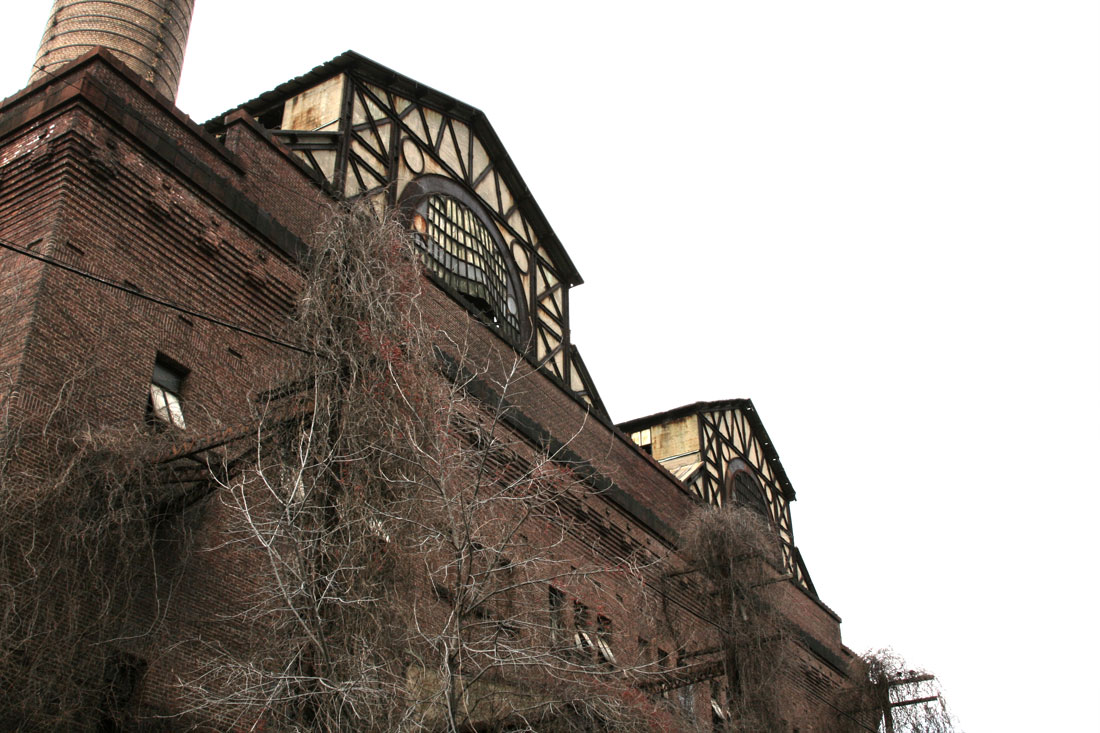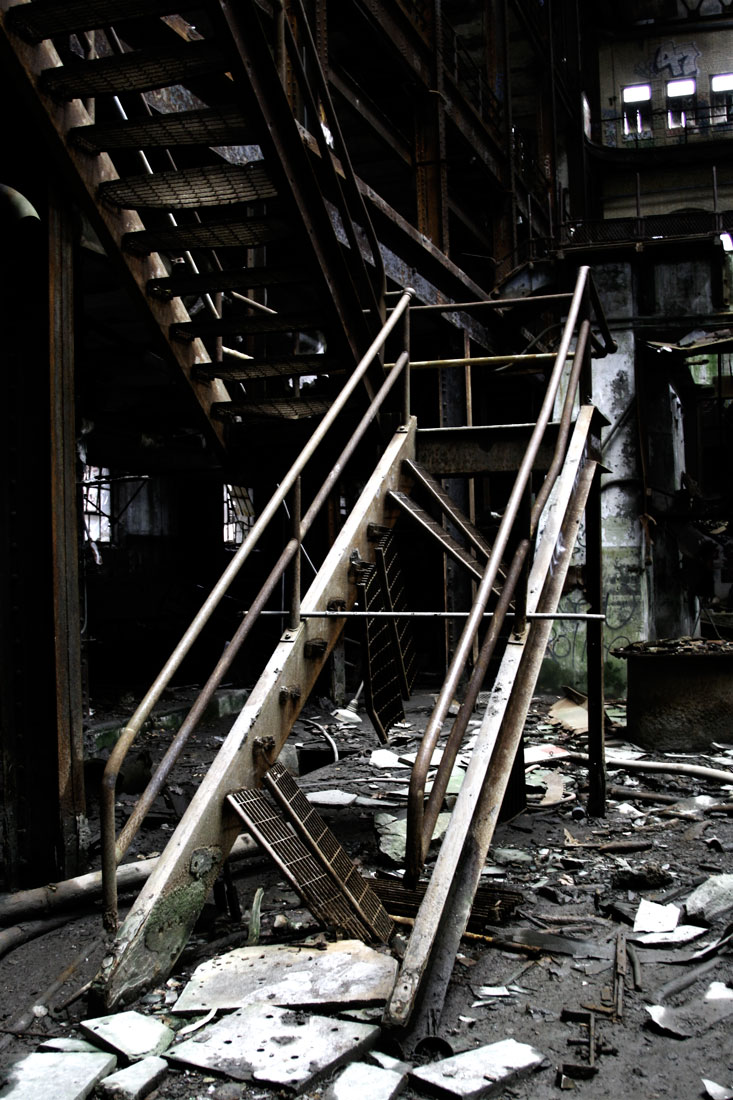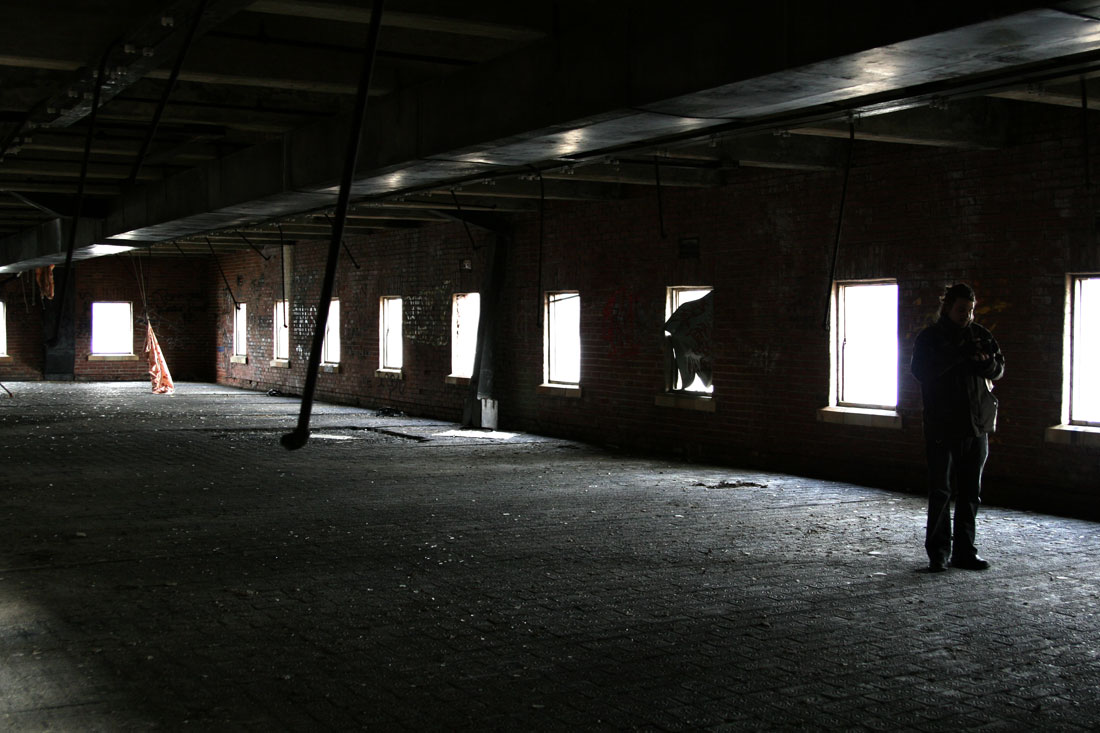The house that once stood in a lot on the corner of West Market and North Highland had been a wine seller’s business in its last legitimate habitation. The house had been empty for years by the time it was torn down. Funny enough, even the corner where the house once stood is gone, the stretch of Highland that reached Market having been paved over to make way for an expanded branch of the Akron Public Library. Now that’s progress.
I remember that house, not very well, but enough to remember that despite its dilapidated appearance and the hanging rot of its beams, my friend Erik and I once ventured inside for a few brief seconds when I was very young. I remember what I saw inside far more vividly than the outside of the house. There was a counter, where the clerk used to serve customers. A set of stairs began to the right of the counter and wrapped around behind. This created a space under the stairs, probably a closet, and there was a door to this behind the counter. A rope was hanging from the ceiling, stopping a foot or two from reaching the floor. On the floor was a beer bottle, one of those squat dark ones that only Red Stripe seems to use anymore. Everything I could see was brown. Walls, floor, ceiling, everything, coated with the same colored dust. I absorbed all of this in no more than a few seconds, standing in the front doorway, because someone started shuffling around in another room, and Erik and I ran back out of the house for our lives.
I never got more than a few steps into that house, and not too long afterwards it was razed. But it sticks out in my memory as my first foray into an abandoned building. Another thing I realize now is that Erik must have been as startled as I was, because he normally would have taken an opportunity like that to play a practical joke on me, something along the lines of shoving me further inside and slamming the front door closed, holding it tight while I wailed and forcing me to wander through the house to find another exit. He was a good friend.

Shane sent me a text as soon as he saw it. Returning with his wife from a trip to DIA Beacon in Dutchess County, he was passing through Yonkers and it loomed above the train, mere feet from the Glenwood station.
The New York Central Railroad began building the power plant at Glenwood in 1904, and finished it in 1906. It has been sitting empty since the 1960s. What Shane saw through the train’s windows that day was a steadfast and immovable corpse. Windows had been shattered, ivy and other plant life had claimed most of the surface of the grounds and the building up through the second story. What doorways he could see were blocked or rusted shut. ‘No Trespassing’ signs hung everywhere, including on the gate, but it was a useless admonition. It was even more useless as a plea. Right next to the sign on the gate, someone had bent open the wrought iron bars, just wide enough to squeeze through.
This was fortuitous timing. I had just bought a camera and had spent some bucks on a halfway decent lens. Shane and I had been talking loosely about urbex for months, absorbing photos from all the best websites on the subject. Abandoned hospitals and jails are among the most popular, while insane asylums are the holy grails of urbex sites. All the two of us needed to jump in was a good, easy site to start with, and a curiosity that couldn’t be satisfied by looking at someone else’s photos.
We set a date, met at Grand Central, and set off for Glenwood on a freezing Saturday in January.
After arriving in Glenwood, we walked the length of the platform, just looking at the power station. It was huge. Red brick and flat-faced but broken up by jutting shapes and windows, it just went up and up, topped by a sloping metal roof and two gigantic smokestacks. This building was from another era of industrial architecture. Just down the tracks we could see a more modern structure, more cost-efficient to be sure, but lacking in any character. It was nothing more substantial than a flimsy metal box. No windows to break up the monolithic nature of its walls, no decoration of any kind, in fact, to show that its designers and its builders gave a damn about it at all.
I think about modern industrial architecture like that every time I see it, and also about gems like Glenwood every time I see one of them being torn down. I think that great industrial architecture is seriously endangered. I think that if I’m still crawling around empty buildings in ten years, all the best buildings will be gone, and I’d do just as well to crawl around in a tin lunchbox. But they don’t make those anymore, either.
I witnessed the destruction of industrial heritage firsthand growing up in Akron — the manufacturing complexes of the rubber giants, Goodyear, B. F. Goodrich, General Tire, Firestone, all largely emptied of their workers by the time I was a toddler. These massive structures sat just as dead as Glenwood, and they were a constant reminder that Akron’s best days were behind it. Parts of the plants found reuse, but when half of the Goodrich plant, which I was most familiar with due to its proximity to my parents’ workplace, met the wrecking ball, it felt like a funeral. It was hardly the first piece of the city to go in my lifetime, but it was the first regret I had at never having explored an abandoned building when I had the chance. What conflicted and self-serving emotions that represents. I want to see these buildings live and thrive, never to be abandoned for as long as possible, but I cherish beautiful decay, and mourn the empty grass fields where broken buildings once stood.
There wouldn’t be any regret at Glenwood, at least. The site was easy to get into. The bent bars of the gate presented no obstacle, and after furtive looks around for watching eyes, in we went.
The small courtyard between the generating building and the office building was clogged with forty years of plants, and the detritus left behind by forty years of drunkenness and petty vandalism. Thick shrubs and trees were surrounded by innumerable empty beer and spray paint cans. To the left was an entry to the generating building, it’s door long since gone.
We crept in, feet crunching dead plants and broken glass, neither of us saying a word. There wasn’t any reverential feeling for the place at this point. That only came after with the nostalgia. We were genuinely trying to be quiet, for a simple reason. Abandoned is an inaccurate description for most abandoned buildings, regardless of their filthiness or inaccessibility. There are no such things as abandoned buildings as long as the floors still hold weight and the roof moderately blocks the weather. At Glenwood, the two of us just assumed we were not the only persons on site, and the last thing we wanted to do was make our presences known by banging about the place recklessly.
The generator room occupying half the building was vast. Completely open from floor to roof, the machines had been removed long ago, but the wonderful space remained.

The floor was sunk a full story into the ground, making it even taller than it appeared from the outside. We had to crawl down to that floor on a section of catwalk someone had leaned into the entryway at some point. The floor was covered in half-frozen mud, probably deposited there from occasions when the Hudson River, which the plant abutted, had overflowed its banks. The skylight, situated directly above in the middle, and a full quarter of the length of the room, let in enough light to illuminate the entire space, and this is where we took our first interior shots. The best shot I got was of a metal staircase, its grated steps bent and smashed down, making it impassable. This was vandalism, not time’s doing. Four stories above us one machine remained — a gantry crane that must have been too much trouble to remove.
Still trying to be quiet little mice, and failing, we made our way to the west end of the building, and back out to the far side of the courtyard. From there, the entrance to the office building beckoned, welcoming us, even. Above the doorway the word ‘entrance’ was indeed engraved.
The stairway immediately inside the entrance was missing steps here and there, but they were passable, having been bridged here and there with thick boards. A couple of the steps had even been repaired at some point, probably by some industrious squatter.
The second floor was divided into two rooms, one passable but littered with bits of lockers and furniture, the other completely filled with junk, very dark and not worth the risk of exploring. Upstairs the openness of the rest of the site that we had seen changed. The walls closed in and the floor divided into many small rooms. This was more than a little forbidding. This was the first place we had been that existed on a human scale, and the long hallway lined with doorways meant that we were confronted with blind corners. It was cold in this building, much more frigid than it was outside, so there was little chance someone would be living there, but that still didn’t stop us from being apprehensive, even if we had ignored caution by venturing into the building in the first place.
The rooms were mostly empty, furniture gone but some old equipment still nested here and there. At some point, someone had lived there. A tattered mattress occupied one room. In a heating vent, someone had tried to start a fire. Everything was old and dry, beyond rotted. It looked like no one had done more than visit this place in years.
The top floor was a welcome reprieve from the closeness of the previous floor. It was opened up into large rooms again, and all sides were lined with windows. The glass was gone, and wind blew in from the river. We were as high up as we were going to get that day, and we could see far up the river. We walked the whole floor and were ready to head back downstairs when we heard people talking outside. The train platform was only just below us, so we figured at first that it was just some people waiting for the train. I leaned out one of the windows above the courtyard to get a look, and didn’t see anyone on the platform. Instead, straight down, I saw three people climbing through the fence into the courtyard.

This was exactly what we didn’t want. We had been wandering around the site for the better part of an hour in perfect peace. The only sounds were the cold wind and the treading of our own feet. Now that peace had been intruded upon, and we were stuck four floors up in an abandoned building that appeared to have only one exit, with three total strangers walking right towards the door. We put our cameras back in our bags and decided to creep back to the stairs and see if we could gauge our situation, to good or ill.
I could see the can on the floor, up there on the fourth floor. I remember it distinctly as it came closer with every step I took. I remember that I could hear whomever it was talking down there through the open windows. I can also remember that as my feet got closer and closer to that can, I thought to myself, “I’m going to kick that can,” and there was nothing I could do about it. I didn’t want to kick that can, but my feet were mischievous, and had other plans. They kicked the can, not me, and to this day, I can still hear the piercing sound of its bounding across the tiles, its shattering echoes off the bald walls of the fourth floor, and I can still hear the deafening silence from down in the courtyard as the three strangers realized, for the first time, that they weren’t alone, either.
“Fuck it,” I said, and headed for the stairs. We climbed down, and I peaked cautiously out the front door. When I did so, with Shane right behind, we managed to frighten three young teenaged boys out of their wits. One of them ran halfway back the way they had come before he realized Shane and I weren’t a pair of axe murderers. We couldn’t tell from four stories up and through a veil of brush, but they were just some kids from the projects up the road, wandering about with nothing to do on a Saturday, and thought they’d check out the big abandoned power station on the other side of the train tracks, the place locals refer to lovingly as ‘the gates of hell.’ As soon as they heard me kick that can upstairs, they had envisioned all sorts of horror that could befall them in this forsaken place, just as we had when we discovered their presence.
They followed us around for a few minutes, then struck out on their own again. Shane and I snapped a few more shots back in the generator room and decided to wrap things up for the day, a full third of the site left unexplored. The rest of the generating building, where two big smokestacks stand suspended on rusting steel girders forty feet above the floor, and everywhere was wrapped with steel catwalk, would have to wait for another day. It felt like the site was through with us, and it was time to leave before we got ourselves into trouble.
Coming up with the answer to why we did it, why we crawled around the power station at Glenwood, subsequent other derelict spaces, and why so many others do the same, is difficult. There’s the surprisingly robust adrenaline rush, senses piqued as every step is considered. Will the floor hold up? Are there other people here that aren’t friendly? Will we get caught? All these questions and more keep heart rates unnaturally high, and positively spiked when something unexpected happens. So there’s a bit of a fear junky aspect at work.
Another reason is purely aesthetic. Decay is photogenic. The monuments of man melting back into the earth is a story as old as civilization, and is where our future will inevitably lead. A place where our vast efforts to hold back the tide of nature have been stopped by bankruptcy or obsolescence, or any number of reasons, finds itself quickly taken back into the fold of the world, crumbling, falling, peeling, swelling and contracting. It’s a process that never truly seems to end, even if all that’s left are some bricks buried beneath new soil. The process has an architecture all its own, and it’s beautiful.
But more important, I think, and the reason I made that first step into the wine seller back in Ohio, is the life abandoned buildings once held. It’s palpable. I don’t believe in ghosts, but it takes little imagination to stand in an empty place and hear footsteps, to let all that far away movement back into the present day, to picture people’s faces and voices as they went about their day at work, relaxed at home, or convalesced in drab iron frame beds. The places where personal stories happened are as powerful as the stories themselves, because they are generally all that’s left of so many performances in life’s play.
